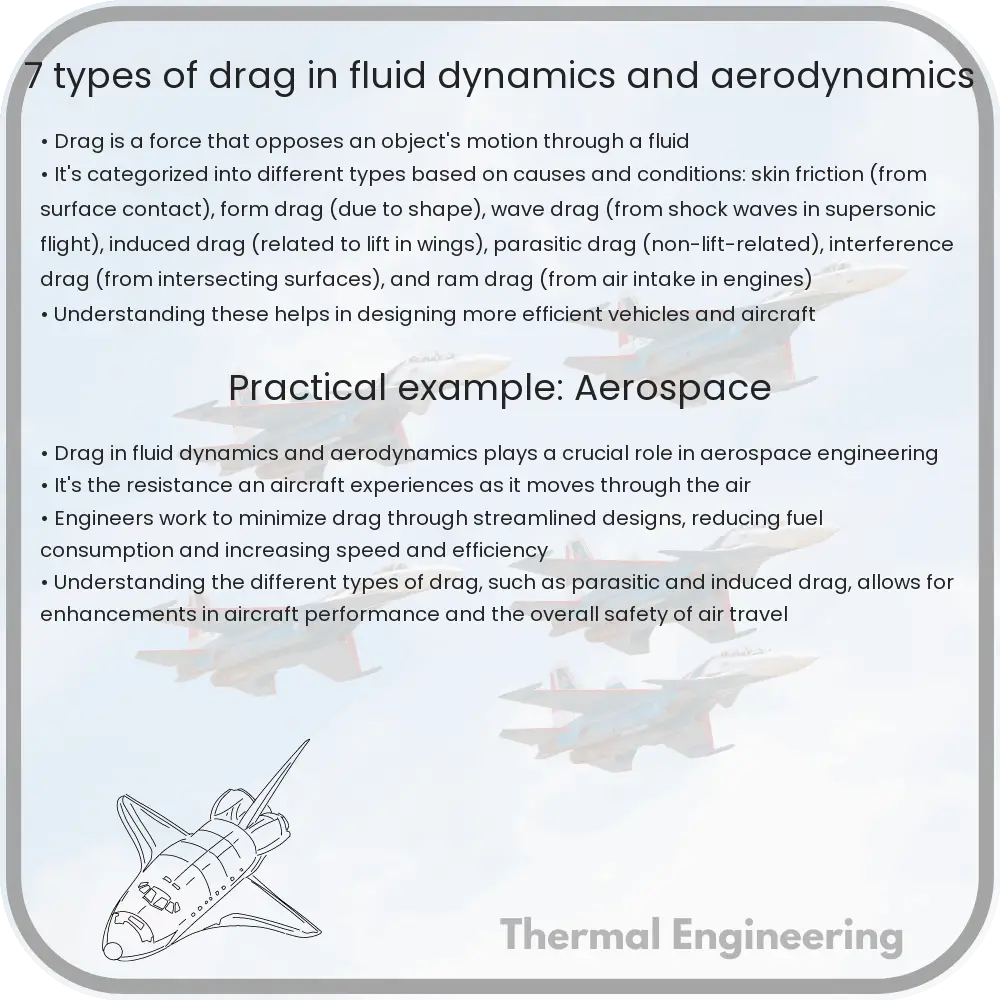Learn about the different types of drag in fluid dynamics and aerodynamics, crucial for designing efficient vehicles and structures.

Understanding Drag in Fluid Dynamics and Aerodynamics
Drag is a force that opposes the motion of an object through a fluid (liquid or gas). This force is crucial in the fields of fluid dynamics and aerodynamics, affecting everything from airplane efficiency to the performance of sports cars. There are several types of drag, each stemming from different physical phenomena. Understanding these can help in designing more efficient vehicles and structures. Below are seven key types of drag encountered in fluid dynamics and aerodynamics:
1. Form Drag (Pressure Drag)
Form drag arises due to the shape of the object moving through the fluid. It is influenced by how the air or liquid flows around the body, creating a wake region of low pressure behind it. The pressure difference between the front and the back of the object leads to this type of drag. Bulky, non-aerodynamic shapes experience higher form drag.
2. Friction Drag (Skin Drag)
Friction drag occurs due to the friction between the fluid and the surface of the moving object. This type of drag is influenced by the texture and material of the object’s surface. Smooth and streamlined surfaces reduce friction drag by allowing the fluid to flow more smoothly over the surface.
3. Induced Drag
Induced drag is particularly relevant in aerodynamics, especially noticeable in aircraft at lower speeds and high angles of attack, such as during takeoff and landing. It is associated with the generation of lift, and its occurrence is due to wingtip vortices that create a pressure difference over the wing. Reducing the wingtip vortices with design elements like winglets can decrease induced drag.
4. Wave Drag
Wave drag occurs when an object moves fast enough to create compression waves in the fluid, such as shock waves formed around aircraft flying at or above the speed of sound. This type of drag is predominant in supersonic and hypersonic flight and is a major factor in the design of high-speed aircraft.
5. Interference Drag
Interference drag happens when varying currents of air meet and interact around different parts of a structure. For example, where the wing meets the fuselage of an aircraft, these interactions can disrupt the flow of the fluid, increasing drag. Aircraft designers typically smooth the transition between different parts to minimize this effect.
6. Parasitic Drag
Parasitic drag is a category of drag that includes form, friction, and interference drag. It is called parasitic because it does not contribute to the functionality of the vehicle, particularly in generating lift in aircraft. This type of drag typically becomes more significant as the object’s speed increases.
7. Base Drag
Base drag is related to the aft end of a body moving through a fluid, commonly seen in vehicles with a blunt trailing edge. The high-pressure area in front of the body and the low-pressure wake behind combine to create this drag force. Aerodynamic tailoring, such as boat-tailing in rockets and cars, can reduce base drag.
- Reducing Drag: Engineers work to optimize the design of vehicles and structures to minimize drag, thereby improving efficiency, speed, and fuel consumption. This is achieved through aerodynamic shaping, selecting appropriate materials, and incorporating technology such as active control surfaces and flow manipulation devices.
- Impact of Drag: Understanding and controlling drag is essential not only in vehicles like cars, airplanes, and ships but also in sports, building design, and even in the environment pertaining to wind flow patterns around natural formations and man-made structures.
In summary, drag is a complex and multifaceted force that plays a critical role in fluid dynamics and aerodynamics. The various types of drag interact with one another, and their cumulative effect dictates the efficiency and performance of moving objects in a fluid environment. By comprehending and managing these different types of drag, significant advancements in technology and design can be realized.